How To Draw A 3d S
Welcome to the definitive guide to cartoon copse. This page features 4 in-depth lessons on how to draw trees using various mediums and approaches.
Use the tabular array of contents below to skip to the lesson of your choice or get through each lesson chronologically.
Lesson I: How to Draw a Tree with Pencil (Graphite)
In this lesson, we'll explore a structured approach to drawing a realistic tree with pencil. The approach that I'll share with you tin be applied to any species of tree and can even be adapted to drawing bushes and shrubbery. In this arroyo, we'll examine specific aspects of the tree and apply what is observed to the cartoon.

You're likely to find the most success drawing a tree from observation, but y'all tin can also apply this method to drawing a tree from your imagination.
What You lot'll Need...
In this example, nosotros'll draw the tree using graphite pencils. Iii pencils are used, but the pencils that you may use are dependent on the pressure level that you lot typically place on the pencil. Ultimately, you'll need to create a full range of value in the drawing. For this reason, a range of graphite grades are used.
- 2H Pencil - Used for establishing the shapes. (Besides much pressure with this pencil could create depressions in the surface of the paper.)
- HB Pencil - Used for developing the mid tones and the lighter values.
- 4B Pencil (or equivalent) - Used for developing the darker values.
Since texture volition play an of import role in the drawing, the surface that you choose to work on is important. For this example, Bristol paper (vellum surface) is used. This paper is very polish, only still has an ample tooth (texture) to take multiple applications of graphite.
Bristol paper provides a skillful amount of control over the mark, merely the texture in the drawing must exist developed through mark-making and value lone. (Item of texture created on Bristol paper is pictured below left.)
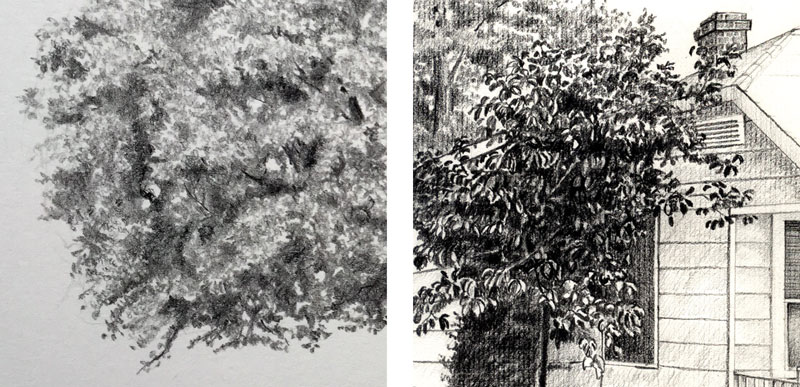
Some will adopt a paper with a greater texture. Working on a surface with a scrap more than molar can help in the development of the texture of the leaves. Charcoal paper is a good solution for those wanting to exploit the surface texture. (Detail of texture created on charcoal newspaper is pictured above right.)
Keys to Drawing Copse
Information technology's easy to become overwhelmed when you look at a tree. There are so many details! Merely to draw i accurately, nosotros demand not be consumed with these details. Instead, we'll breakup the tree into 3 simple aspects. We'll develop each attribute individually, following a structured approach.
Footstep 1 - Discover the Shape(southward) - The first affair we'll do is define the overall shape of the tree. Drawing lightly with the 2H pencil, nosotros'll concentrate only on the outer contours.
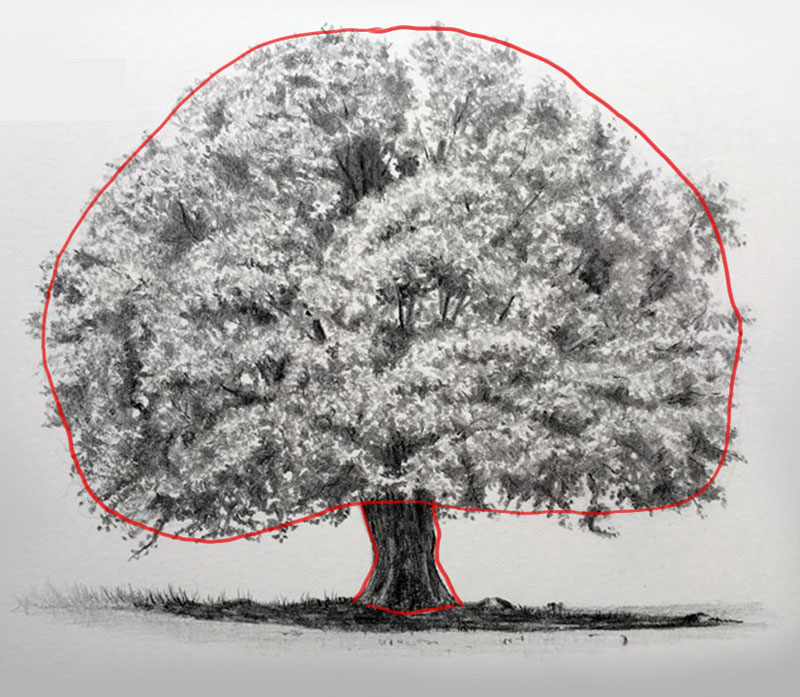
With the outer contours defined, we'll adjacent find the smaller shapes within the canopy of the tree. These locations are "clumps" or collections of leaves found at the end of the branches.
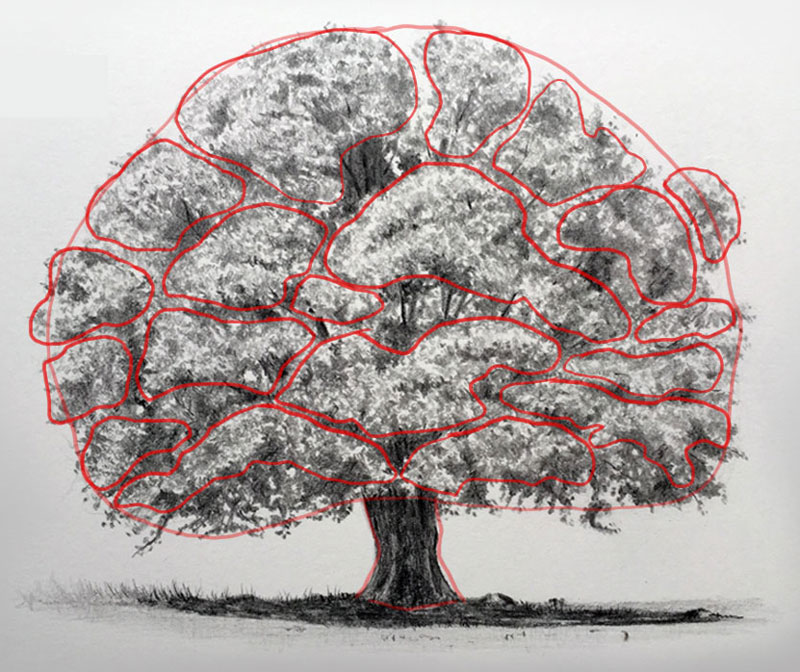
Footstep 2 - Develop the Texture - Using the divers shapes as a guide, nosotros'll start to develop the texture of the leaves. This procedure requires patience. Take your time and remain consistent. It is not necessary to draw every leaf, instead we'll create the illusion of collections of leaves. Nosotros'll think about each "clump" or drove of leaves equally a form, developing the highlights and shadows on each.
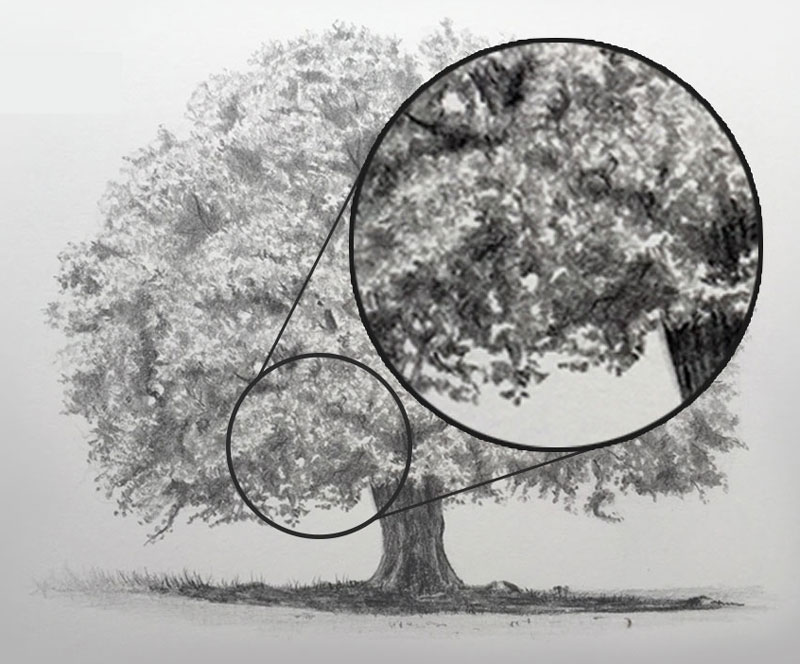
Organic collections of lines tin be used to create the illusion of the texture. These lines may be small squiggles that overlap. Be sure to leave an organic and irregular border effectually the outer contours of the tree and leave modest open up spaces inside the canopy.
Step 3 - Develop the Value - The illusion of texture is created not merely by the marks that are fabricated, merely also through the development of the values. Value is the darkness or lightness of a color. Information technology is responsible for communicating not merely the light within the scene, but also the form and texture of the object. Our goal is to create a full range of value, including the darkest "darks" and the lightest "lights".
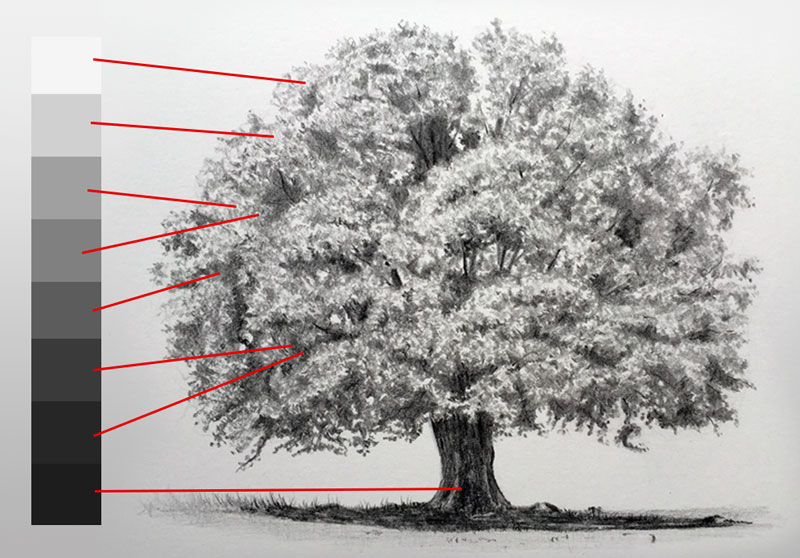
Additional Considerations
1. Take Your Time - Equally mentioned before, drawing a realistic tree requires patience and persistence. (This is actually true for any subject that you depict.) Far too many people believe that cartoon should be quick and easy. Sometimes just "slowing down" and patiently developing the drawing leads to considerable improvement.
ii. Y'all Are Creating an Illusion - Drawing is an act of illusion. It is the development of the shapes, textures, and value that create this illusion. There'south no need to draw everything that you see. Instead, concentrate on how yous can create the illusion of what you see.
iii. Deviations are Acceptable - When drawing from observation, deviations from the original reference or subject field are inevitable. Creating an exact copy of your subject probably shouldn't exist your goal. Don't put unnecessary pressure on yourself to be "perfect". This volition just atomic number 82 to frustration.
Lesson Ii: How to Draw a Tree with Pen and Ink
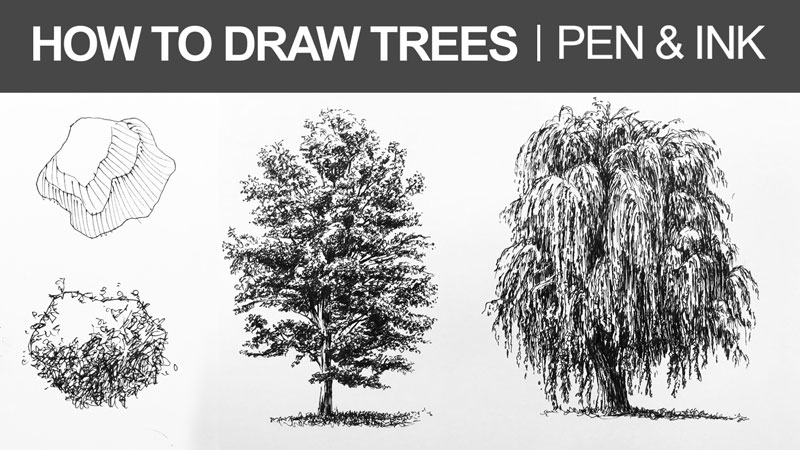
Bones Elements to Consider When Drawing a Tree
When nosotros create a drawing of a tree with pen and ink, nosotros'll consider the aforementioned bones elements. Remember, the details that we see - the leaves, branches, and trunk can all be simplified, making the illusion that nosotros create in a drawing a fleck more manageable. When we draw, nosotros create an illusion - not always an exact copy of what nosotros see.
Only like with graphite drawing, creating this illusion in a pen and ink drawing can be achieved past focusing on 3 key elements:
- Shape
- Course
- Texture
The following video demonstrates how to draw a tree with pen and ink by focusing on these three basic elements.
Recognizing the Shape of the Tree
Trees are clearly organic subjects and the shapes that they create are too organic. The kickoff thing that we need to recognize is the overall shape of the tree which will vary based on the type of tree that you are cartoon.
To recognize the shape of the tree, expect at the overall contour of the shape. If you struggle with seeing this, try squinting your eyes - blurring out the details. Expect at the outer edges of the tree and simplify what you lot are seeing into a line that can be enclosed.
This overall shape tin exist loosely sketched with a graphite pencil. Employ a light bear on so that the graphite can be erased easily once ink applications have been made. Brand comparisons between your drawing and what you are seeing and make any necessary changes.
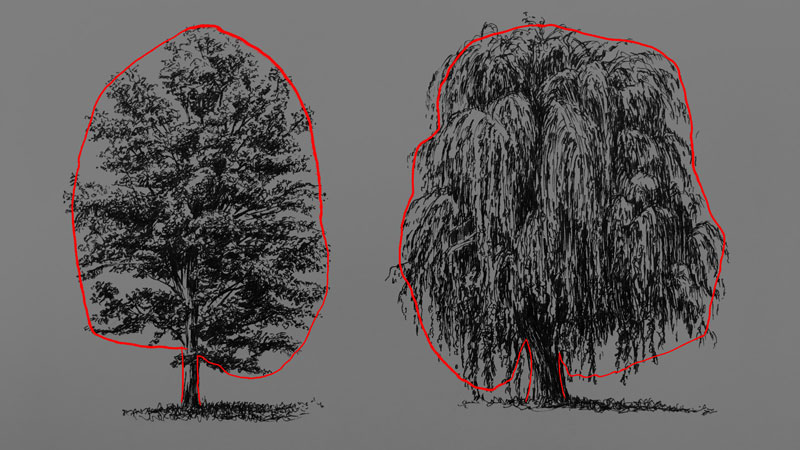
Finding the Shapes Inside the Tree
With the basic contour in identify, we can brainstorm to locate smaller shapes that happen inside the body of the tree. Copse are made up of collections of leaves and branches that extend from the trunk. These collections of leaves and branches are forms but before we develop the illusion of these forms, nosotros must recognize the basic shapes that they create.
Once again, these basic shapes tin be lightly sketched with a graphite pencil. Nosotros aren't concerned with the details of the leaves at this bespeak. Instead, we only want to simplify the collections of leaves into basic shapes. The shapes that y'all draw will again vary based on the type of tree that you are drawing.
If you lot find that recognizing these basic shapes is hard, try looking for areas of contrasting values. Typically, darker values are constitute on the lower portion of each shape with lighter values on the top.
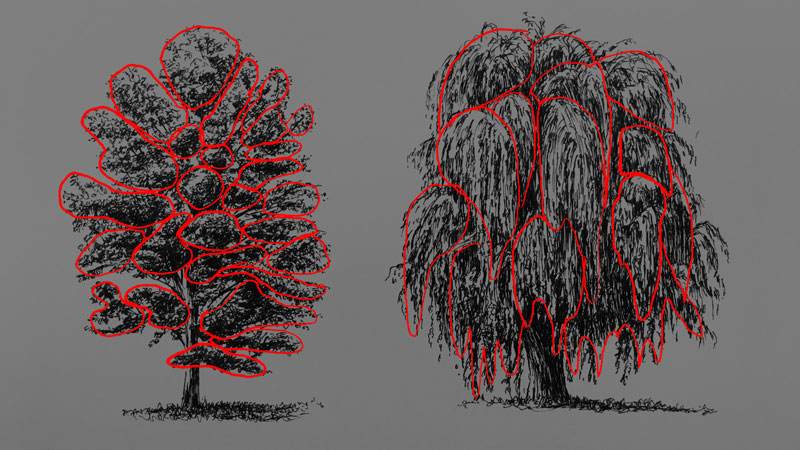
Creating the Illusion of Form
Now, we demand to create the illusion of grade. In order to create this illusion, we'll need to consider the light source and add together darker values in locations of shadow while leaving areas of lighter value in locations of highlight. The fundamental to creating the illusion of course with any discipline lies in the locations of value.
For each of the smaller shapes that nosotros drew in the last step, we'll add darker values in the locations of shadow. These areas of shadow exist mainly on the opposite side from where the low-cal source originates. And similar with basic forms, there will be a gradation of value from low-cal to dark, creating locations of midtone. Since these forms are irregular, the locations of shadow and heart values are as well irregular.
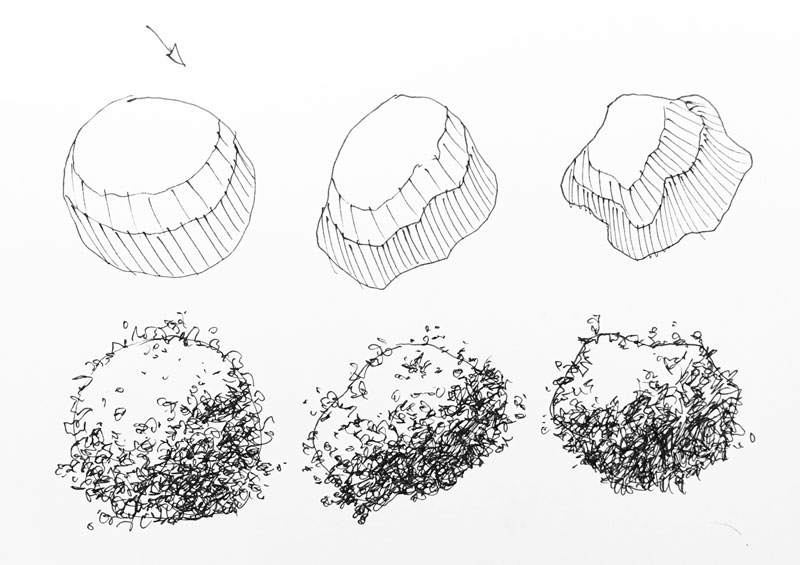
These values are added and developed through textural marks that resemble the texture of the leaves. Textural marks are more concentrated in locations where the value is darker and more thin in areas where the value is lighter.
Adding Texture to The Tree with Pen and Ink
When drawing with pen and ink, the values that are created are more often than not dependent on optical mixing. Since every mark is dark, even when practical with low-cal pressure, we must rely on the white of the newspaper to affect the perceived value. This is important to recollect since we are building up the value as we develop the texture.
It's easy to become focused on each individual foliage when drawing a tree. Just in our drawing, we don't need to draw every single i. Instead, we need to mimic the texture that is perceived. Surprisingly, this can exist accomplished with very loose marks with pen and ink.
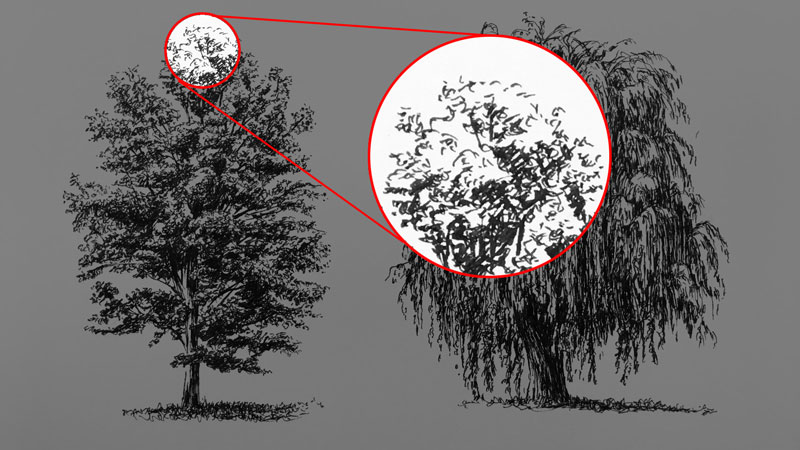
With many species of trees, small squiggly lines made with the pen tin can create a convincing texture.
No matter what blazon of pattern you decide to use for developing the texture, information technology'due south important to stay consistent. Make sure that the marks that you lot add to the top of the tree are consistent with the marks that are used to describe the eye and bottom of the tree.
Fifty-fifty though loose, squiggly marks result in a believable texture, it doesn't mean that this process is fast. Have your fourth dimension and patiently develop each department. Take breaks if necessary. Working slowly will pay off in the end.
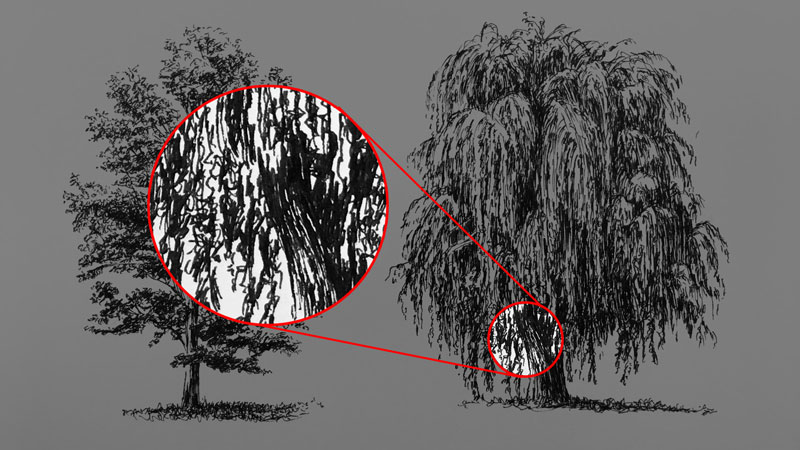
Directional strokes tin can exist used to develop the texture of the trunk of the tree. Again, nosotros can concentrate these marks in areas of shadow and let them to become more than sparse in areas where light is striking.
Fifty-fifty a subtle change in the textural marks that you make will produce enough contrast to communicate a different texture in the drawing.
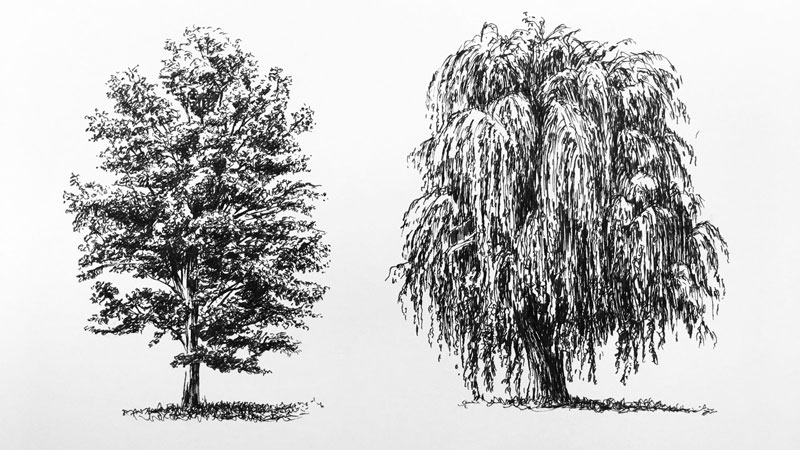
In one case all of the ink applications take been made and allowed to dry completely, a kneaded eraser tin be used to remove any of the graphite guidelines that may be visible.
Lesson Three: How to Draw an Old Tree with Charcoal
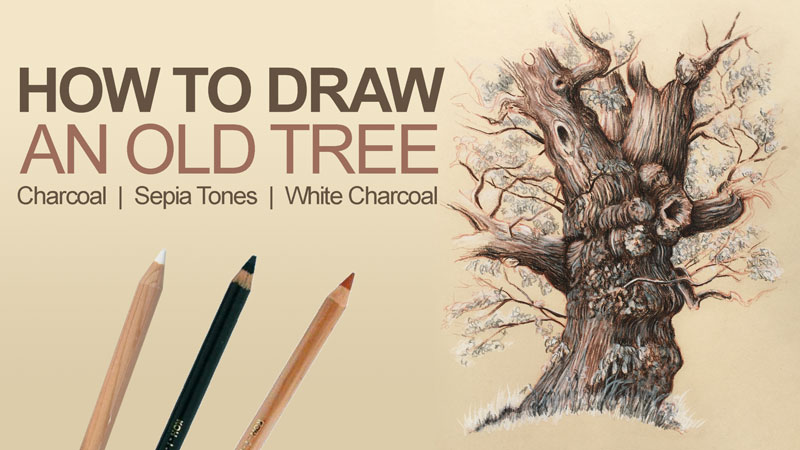
Capturing The Character of a Old Tree in a Cartoon
Every living thing has its own personality and copse are no different. As artists, part of our duty is to capture the personality of the subject field - the character of the entity - in our drawings. This tin exist a daunting task if nosotros allow ourselves to become overwhelmed with details or become as well obsessed with realism. Simply if nosotros look for bits of visual information that tin be exploited in the class of a cartoon, then we're likely to capture the graphic symbol, resulting in a drawing that is accurate while still telling a visual story.
When information technology comes to trees, the grapheme is frequently found in the shapes, lines, values, and textures - the aforementioned things that we would look for if our goal was to create a photo-realistic drawing.
The following video demonstrates the process of drawing an old tree with charcoal and sepia tones.
Cartoon with Charcoal and Sepia Tones
Charcoal, a black powdery medium from burnt organic fabric, and the reddish-brown tones of the color, sepia are a friction match "made in heaven". The earthy tones of any sepia textile, whether it be pastel or conte, marry well with the rich darks produced past charcoal. And when you add together a little white charcoal into the mix, a beautiful range of value and color can be accomplished.
What is Sepia?
Simply put, sepia is a range of color from browns to reds. All sepia tones take a bit of earthy red and brown in them in varying degrees. Originally, sepia ink was widely-used every bit a writing ink in early on Greek and Roman civilizations and was also used by artists - perhaps most famously, by Leonardo da Vinci.
Sepia tones are used in every artistic medium from photography to painting. They can exist used as color enhancements in photos to make them announced older or as underpaintings. The softer tones produced past sepia colors add a affect of color to an otherwise monochromatic limerick.
Sepia tones are often used alongside charcoal to soften the strong blacks produced the textile. The reddish-browns also add together a flake of color to the drawing, adding interest. Sepia tones are near effective when used for subjects that already have reds and brown in them naturally, such as portraits and landscapes.
How to Draw an Erstwhile Tree Footstep by Step
In this lesson, we're working on toned Stonehenge paper (Fawn, Vellum surface). Stonehenge papers are 100% cotton which results in a soft surface. Softer surfaces naturally produce a softer marking which may be preferred past some artists.
We'll begin by lightly drawing the contours of the tree with a Ruby-red Chalk pencil from the Gioconda pencil line from Koh-i-noor. Although this pencil is labeled as a "chalk" pencil, information technology feels and behaves like an oil pencil.
The marks at this stage are calorie-free and loose as we try to notice the boundaries of the subject. The most important element at this phase is the cadre of the trunk and the branches of the tree. We'll also exaggerate the contours a bit, making them bumpier. This will add some character to the tree and get in announced a flake older.
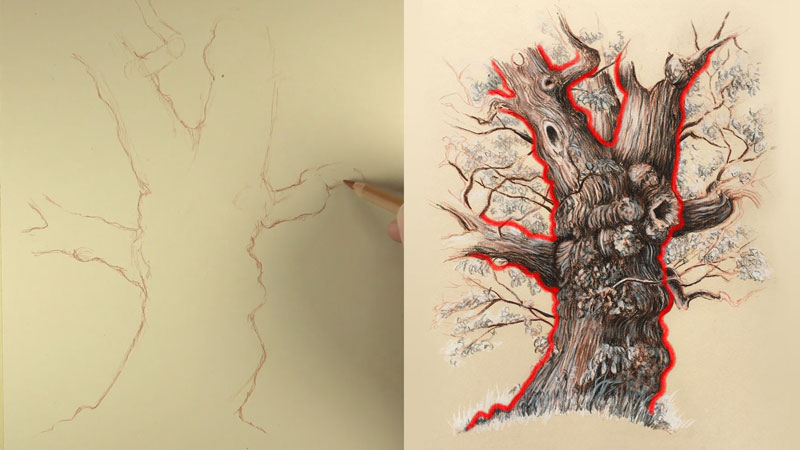
It may be helpful to think of the branches as tubes or cylinders. It'due south piece of cake to add branches that extend from the edges of the torso, just some of these should bend and plow towards and abroad from the viewer. Drawing the branches in this manner adds depth.
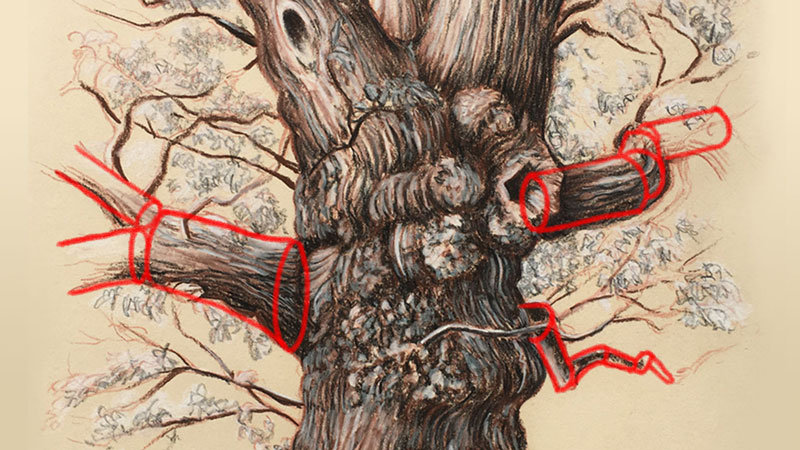
Once the contours are loosely sketched, nosotros can enhance the line quality. Line quality refers to the thickness or thinness of the line. There should be some variety hither. Generally, portions of the tree that are thicker tin can exist defined by a thicker line. This ways that we can revisit the core of the trunk and make the lines that ascertain information technology a little thicker.
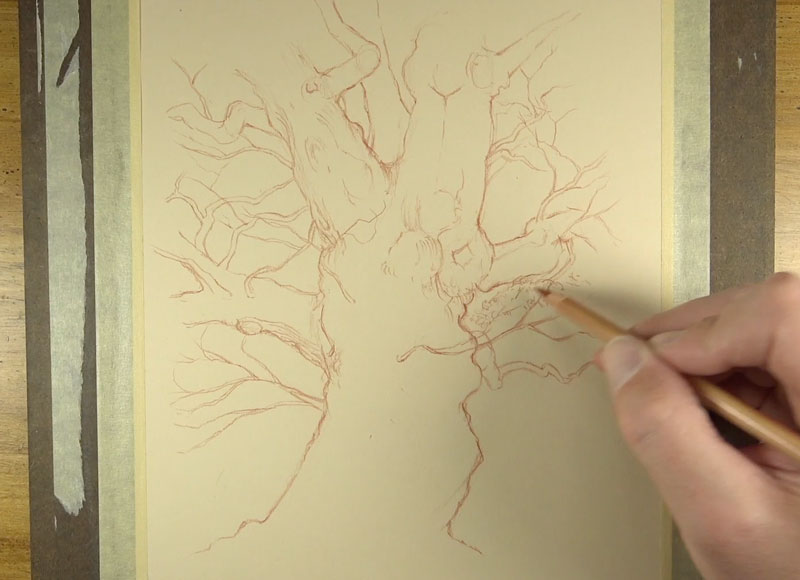
Now that the contours are in place, we can outset to develop the texture on the trunk of the tree. By and large, this texture is defined by line applications. The directional lines that nosotros add here are of import and should flow with the form of each section of the tree. Lines that flow over the form of the subject are referred to as "cantankerous contour lines". Information technology's important to signal out that the texture of the tree changes throughout. In some areas the lines are predominantly direct, while in other locations the lines may be made upward of smaller circles.
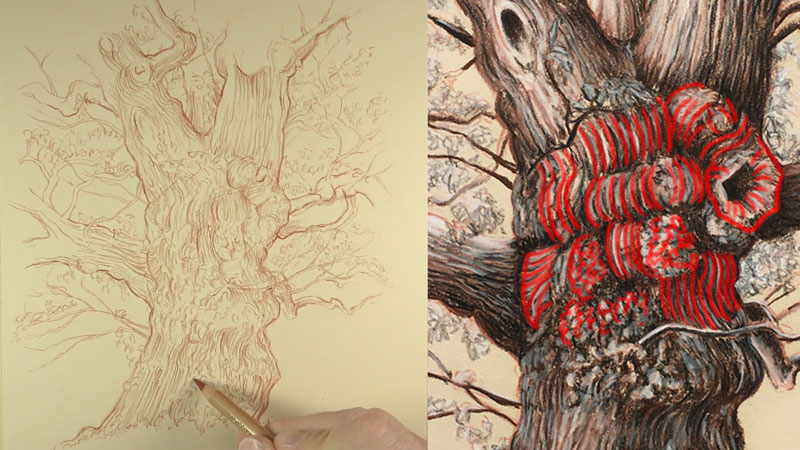
Now nosotros're ready to begin addressing the value range. Value is the darkness or lightness of a color. Value communicates the form and texture of the subject. We'll start by applying an application of white charcoal over the majority of the tree. By doing this, we can preserve the lighter areas before developing the darker ones. The stroke of the marking should be considered here every bit well. Simply like in the last stride, we'll make marks that menses with the cross contours.
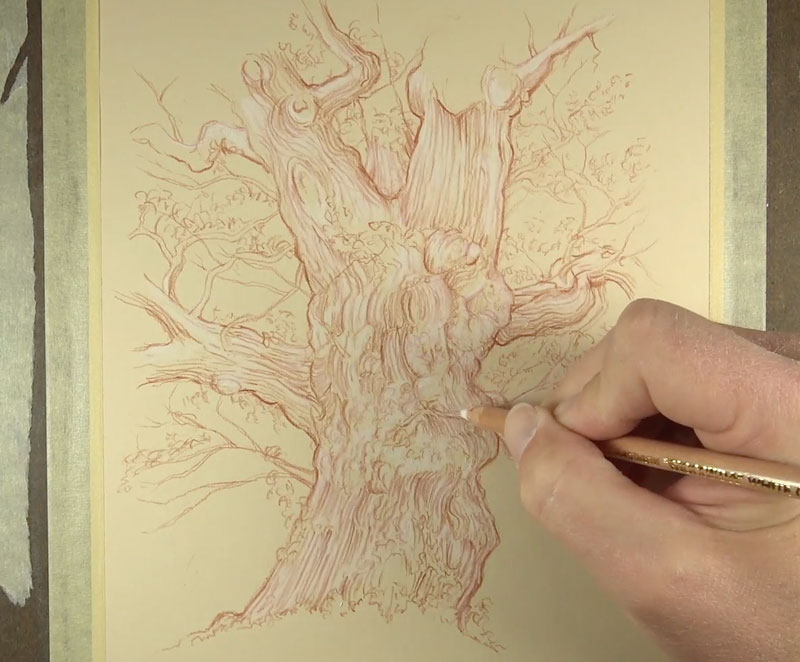
We'll begin introducing darker tones and midtones with a Sepia Lite pencil from the Gioconda line. This pencil is powdery and behaves in a similar manner as a pastel pencil. Since the calorie-free source originates from the upper left, darker tones are full-bodied on the right side of the tree. Even so, since the tree is curved, some darker tones are too found on the left side. Again, strokes practical with the pencil flow with the cantankerous contours.
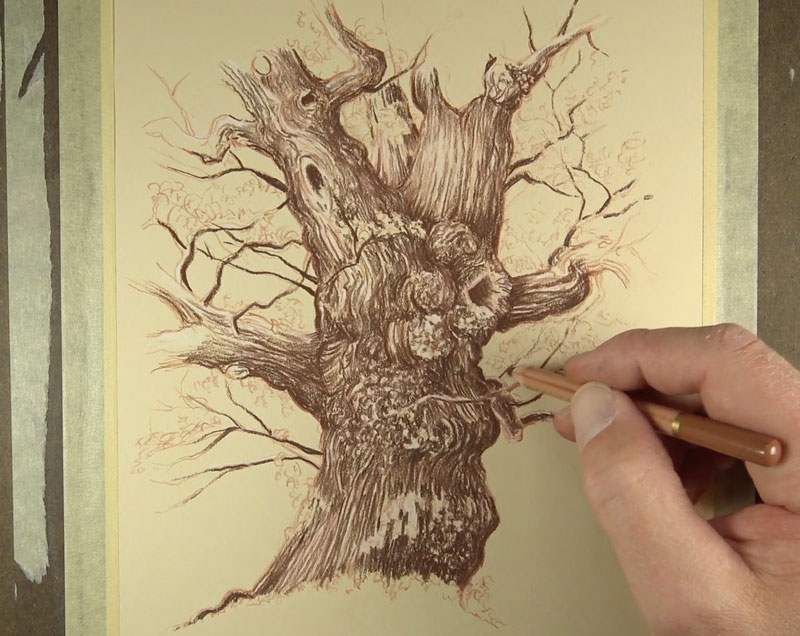
Before going fifty-fifty darker, the white charcoal pencil tin can be used to soften areas where the contrast may be as well demanding.
Now we can push button the darker tones with a charcoal pencil. We shouldn't cover the applications made with the Sepia Low-cal pencil completely, but instead focus on the locations where the value should be very dark. Over again theses locations be on either side of the tree, but are more than dominant on the side opposite from the calorie-free source.
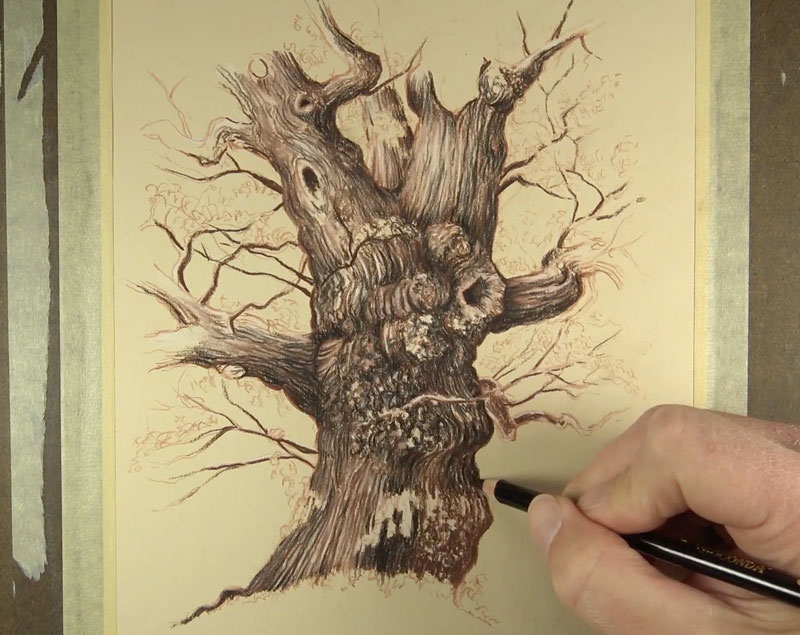
We tin can now go back with a sharpened white charcoal pencil and enhance the highlights further. This broadens the range of value and increases the contrast. Edges are then refined and blacks deepened using a Negro pencil.
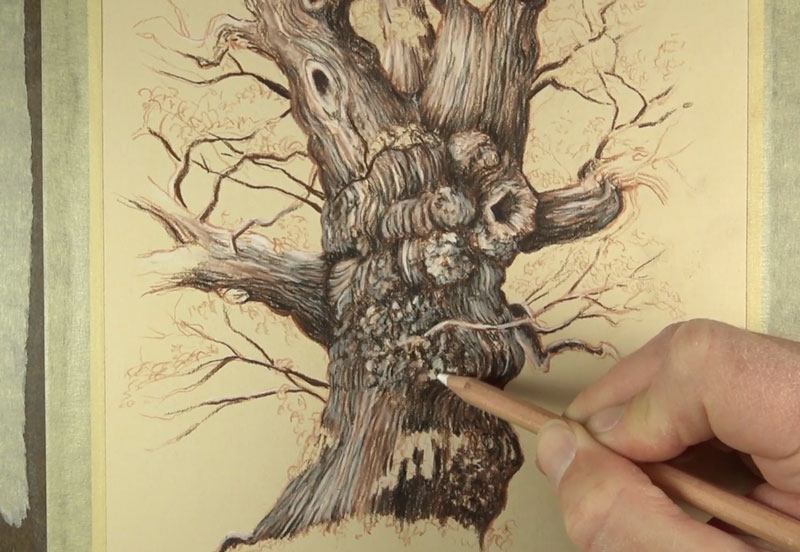
We can then make full in loose indications of leaves and grass at the bottom of the tree and throughout the canopy using a combination of the white charcoal pencil and Negro pencil to complete the image.
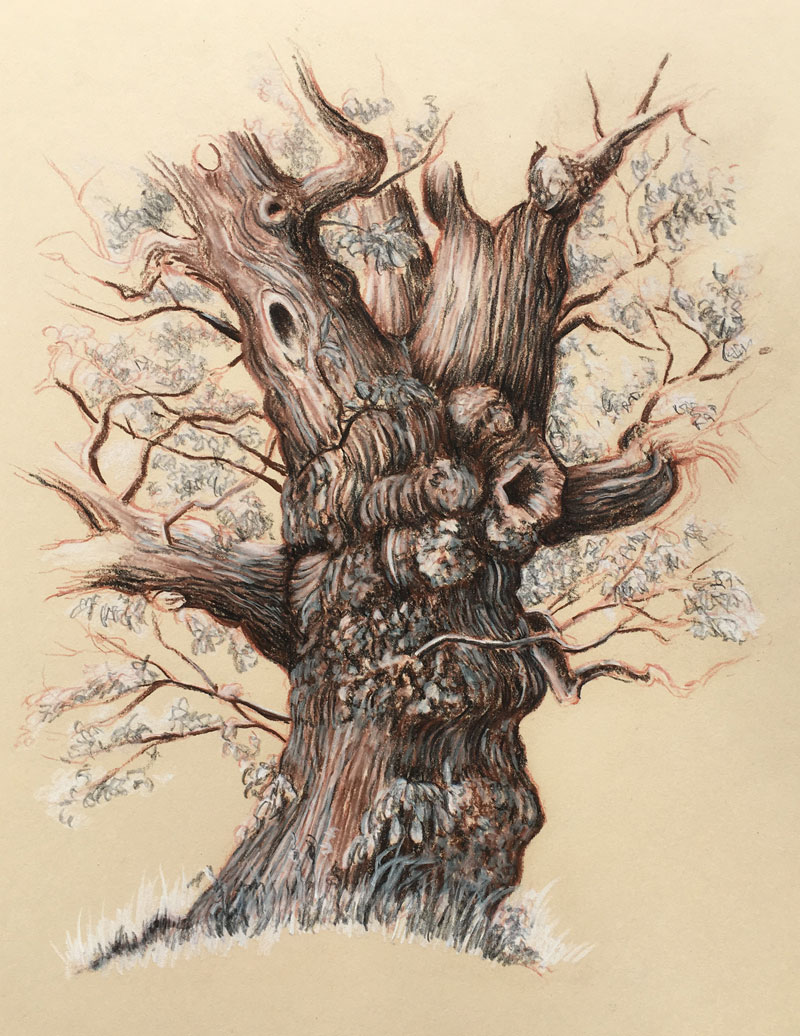
While the combination of charcoal and sepia tones tin exist used for any bailiwick, they work best when applied to those that naturally contain ruby-red earth tones like our tree. The procedure is quick without sacrificing much control. And when it comes to cartoon trees and capturing their graphic symbol, focus on the basic shapes, lines, and textures - exaggerating them when possible.
Lesson Four: Drawing Trees with Colored Pencils
Drawing is all well-nigh creating an illusion. We meet the world around us every bit lines, shapes, forms, textures, and colors. This is how our eyes run across things anyway. It is our minds that make sense of these things. Our mind tells us what we are seeing, not our eyes.
As artists, nosotros are in the business organisation of creating illusions. We rely on the style in which our optics piece of work in order to "play tricks" the minds of those that view our fine art.
Bug typically arise when we allow our minds to get in the way of what our eyes are actually seeing.
Although, we are discussing how to draw a realistic tree in this tutorial, this concept of drawing applies to any field of study that you may want to tackle.
The Importance of Texture
When information technology comes to drawing trees, texture will play a crucial function. We will need to mimic the observed texture of the leaves of the tree, without drawing every single leaf. So, our goal is to create - you guessed it - an illusion.
This illusion is created by relationships of value. The positioning of the dark and light tones will non simply give class to our tree, but also create the illusion of groupings of leaves. It is the dissimilarity between the darks and the lights that will translate as private leaves to our viewers.

Nighttime values will exist in adumbral areas, while lite values will exist in areas that are receiving calorie-free.

The Colors
Since nosotros are edifice upwards the illusion with colored pencils, we will need to consider the value of the colors that are used. The leaves on the tree in this demonstration are green. We'll mix areas on the tree to create lighter and darker values using yellow, blue, brownish, blackness, and white. Not simply volition this push the value range, but information technology will as well expand the depth in the colour.
The blue that is used is darker in value, then it is used to develop the shadowed areas of the tree.

Yellow is naturally a lighter value equally a pure hue, so it is used in the areas that are receiving low-cal. Darker values are enhanced using brownish and blackness, while lighter values are enhanced using white.

The Marks
The marks that are made are also of import. Marks can exist made to mimic the texture of the leaves using small irregular circles. Drawing each individual leaf would be counter-productive and is unnecessary. Retrieve, we are creating an illusion based on how how our minds perceive the world around us. These small marks will suffice to create this illusion.
Nosotros will also need to consider spaces that exist in the canopy of the tree. The trend is to overlook these openings, merely including them is incredibly of import.

Of form, these open spaces provide more opportunities for cartoon the branches that are visible, which add to the overall illusion that nosotros are after.
Other Tips
Like with virtually colored pencil drawings, layering and building up colors is especially important. Most of the time, ane application of color will non be enough to create the required depth in color to create a realistic appearance. Fortunately, colored pencils are piece of cake to layer and blend nicely.
Showtime light when layering colors. It is much easier to build up colors when initial layers are applied with a light manus early in the cartoon. Layering lightly in the early stages prevents build up of the binder which could hinder heavier applications applied later in the drawing process.
Be patient. Colored pencils are a medium that requires patience. It is a time consuming process to layer the pencils properly to create the required illusion. Too often, beginner artists wait immediate results, when time should be devoted to developing a colored pencil drawing.
Source: https://thevirtualinstructor.com/how-to-draw-trees.html
Posted by: epleymisibromes.blogspot.com


0 Response to "How To Draw A 3d S"
Post a Comment